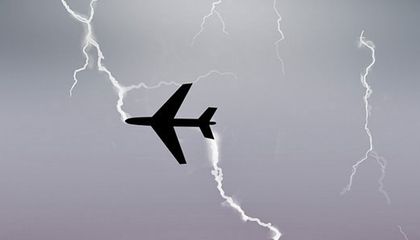Aerospace
How a hero pilot averted disaster Collision in mid-air

Following reports that the state carrier’s plane narrowly avoided a mid-air collision with a British Airways flight over Turkey, putting the lives of nearly 500 passengers in danger, SriLankan Airlines praised its pilots for safely commandeering a flight from London to Colombo. The airlines also praised the pilot’s talents, as well as the communication and surveillance systems, for averting a major disaster. It should be noted that flight UL 504 was flown by an Airbus A333.
The national carrier claimed on June 13 that “the pilots’ vigilance and the state-of-the-art communication and surveillance systems onboard the aircraft allowed safe passage for UL 504”.
Furthermore, SriLankan Airlines commends the pilots operating UL 504 for their prompt action, which secured the safety of all passengers, crew, and equipment onboard UL 504, the company stated in a statement.
After media sources indicated that UL 504, flying from London to Colombo, escaped the worst potential mid-air collision while in Turkish airspace, the correction was provided. According to accounts, the Airbus A333 aircraft carrying 275 passengers had crossed Turkish airspace after departing Heathrow on its way to Colombo. The Srilankan aeroplane had been instructed to rise to 35,000 feet from the current altitude of 33,000 feet.
The Srilankan jet noticed a British Airways flight with more than 250 people on board about 15 miles away, travelling at 35,000 feet, and contacted Ankara’s air traffic control.
Ethiopian Airlines Refutes the Wrong Reportings of the New York Times
Despite being cleared twice incorrectly by Ankara air traffic control, the Sri Lankan pilots refused to rise. Minutes later, air traffic control replied quickly, warning the Srilankan jet not to climb because a British Airways flight to Dubai was already at 35,000 feet.
If the UL pilot had climbed to the requested height, the UL flight would have collided with the British Airways jet, which was flying faster than the UL flight, according to the Daily Mirror newspaper.
The passengers and crew safely departed from the flight after landing at Bandaranaike International Airport here, and a report on the event was filed, according to the statement.
A 13-year-old Qantas Airbus A380 is being scrapped in Victorville.

Aerospace
Boeing Transfers Rocket Stage to NASA, Paving Way for Human Moon Mission

Boeing has achieved a significant milestone by providing NASA with the second core stage of the Space Launch System (SLS) rocket.
This crucial component, crafted at NASA’s Michoud Assembly Facility (MAF), is set to propel the Artemis II crew into lunar orbit, marking humanity’s return to deep space after a 50-year hiatus.
The monumental Boeing-built rocket stage, the largest element of the Artemis II mission, will embark on a journey aboard the Pegasus barge, traveling 900 miles to NASA’s Kennedy Space Center.
Comparison of two legendary aircraft B777x vs B747 aircraft:Click here
Upon arrival, it will be meticulously integrated with other essential Artemis II components, including the upper stage, solid rocket boosters, and NASA’s Orion spacecraft within the iconic Vehicle Assembly Building. This intricate integration process is a vital step toward the eagerly anticipated Artemis II launch, slated for 2025.
“Boeing-built products helped land humankind on the moon in 1969, and we’re proud to continue that legacy through the Artemis generation,” remarked Dave Dutcher, vice president and program manager for Boeing’s SLS program. “Together, with NASA and our industry partners and suppliers, we are building the world’s most capable rocket and paving the way to deep space through America’s rocket factory in New Orleans.”
NASA, Lockheed Martin Reveal X-59 Quiet Supersonic Aircraft:Click here
The delivery of Core Stage 2 marks a significant achievement in the evolution of the SLS rocket. Towering over 200 feet and powered by four RS-25 engines, this core stage, coupled with two solid-fueled booster rockets, will generate a staggering 8.8 million pounds of thrust. This immense power is crucial to launching Artemis II and future missions into the vast expanse of space.
The SLS rocket stands unparalleled in its capability to transport both crew and substantial cargo to the moon and beyond in a single launch. Its extraordinary capacity will facilitate the delivery of human-rated spacecraft, habitats, and scientific missions to destinations including the moon and Mars, ushering in a new era of space exploration.
-

 Travel1 week ago
Travel1 week agoAir India to Expand US Operations with Three New Routes After a Decade
-

 Travel2 weeks ago
Travel2 weeks agoWhy We Should Avoid These Stamps in a Passport
-

 Airlines1 month ago
Airlines1 month agoInvestigations Reveal Fake Chinese Titanium in Boeing and Airbus Jets
-

 Tech4 weeks ago
Tech4 weeks agoChina’s CATL Plans 1,800-Mile Electric Plane Launch by 2027
-

 Airport3 days ago
Airport3 days agoTop 10 Largest Airports in the World by Size
-

 Aerospace4 weeks ago
Aerospace4 weeks agoChina’s Fighter Jets Turn Wings into Autonomous Drones
-

 Airlines4 days ago
Airlines4 days agoAir India Rolls Out A350s for Delhi-New York JFK and Newark Routes
-

 Defence3 weeks ago
Defence3 weeks agoBoeing Enhances Chinook with New Engines and Block II Upgrades at $96 Million







